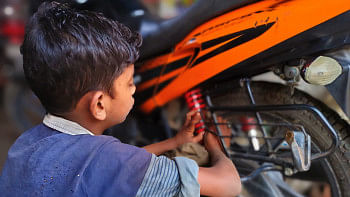Our child labour issue needs urgent attention

Child labour continues to persist in Bangladesh. The latest National Child Labour Survey (NCLS) reported an increase from 1.70 million in 2013 to 1.78 million in 2022. This increase is likely due to increased poverty caused by the Covid pandemic. Nonetheless, the positive economic performance of the last two decades should have decreased child labour, given that poverty is often cited as the primary reason behind child labour. Immediate policy action is required in order to reverse this increase in child labour.
Work adversely affects children's health and also human capital development, subsequently affecting future earning opportunities, and thus having an intergenerational effect. Relevant research suggests a range of harmful effects of labour on children, such as low body weight, higher rates of illness and injury, decreased self-esteem, increased anxiety and depression, and poor academic performance due to absenteeism, and early dropouts.
However, not all work performed by children is considered harmful. In many low-income countries, household chores and outside work are performed by children who are also in school. And if working hours and school hours do not overlap, working is considered mostly positive. However, the effects of child labour depend on working conditions, type of work, hours and, most importantly, whether or not work hampers children's physical and mental development.
In Bangladesh, the majority of children working in hazardous conditions are in the rural areas, where a significant number are engaged in family-based agriculture and non-agriculture businesses. It is observed that children of landless farmers work as paid or unpaid labourers, as domestic helpers, or engage in trading or apprenticeship.
Structural transformation in the last three decades has created job opportunities in the suburbs and metropolitan areas, which has attracted many economic migrants from rural areas. Many of these households cannot manage a consistent income and end up depending on their children's earnings.
An alarming trend is the significant increase in the number of working children in the age group of 12-13 years—from 0.04 million in 2013 to 0.59 million in 2022—and their involvement in hazardous work, which has more than doubled in the last ten years. These ages correspond to the ages of students in the first year of secondary school in Bangladesh. Although many children manage to combine schooling with work (the 2022 NCLS reports that the number of child workers not attending school has declined from 1.07 million in 2013 to 0.85 million in 2022), dropout rates are still high in the secondary level, at 35.98 percent in general and 40.78 percent for girls. It should also be noted that primary education is free and compulsory in Bangladesh, but secondary and above are not and many children cannot afford the costs of schooling. Lack of quality education and anything above primary education not being free-of-cost are two factors that discourage many parents from sending their children to school. These parents prefer sending children to work (instead of sitting idle) to acquire some skill and experience, with the expectation that this would help them find a job in future.
The vast majority of empirical literature has identified poverty as the fundamental reason behind child labour across countries. In addition, birth order is found to be a significant determinant of child labour. For example, in Bangladesh first-born children are more likely to go to work or combine work with schooling, compared to their younger siblings. Social norms may also lead to intergenerational child labour. Parents who were child labourers are more likely to send their own children to work. Conversely, when social norms internalised in a society veto child labour, societal disapproval can help keep parents from sending their children to work.
As child labour is caused by multiple factors, various policies should be implemented in order to reduce it. Ensuring inclusive and quality education for all children, as is the target of SDG 4, will require massive expansion and quality improvement of Bangladesh's education sector, both in general and technical regards. Various poverty reduction policies (such as access to credit, cash transfers, and stipends for students) will also contribute to a reduction in child labour.
Farzana Munshi is professor of economics at BRAC University and a professorial research fellow at Global Development Institute of University of Manchester.
Views expressed in this article are the author's own.
Follow The Daily Star Opinion on Facebook for the latest opinions, commentaries and analyses by experts and professionals. To contribute your article or letter to The Daily Star Opinion, see our guidelines for submission.

 For all latest news, follow The Daily Star's Google News channel.
For all latest news, follow The Daily Star's Google News channel. 











Comments